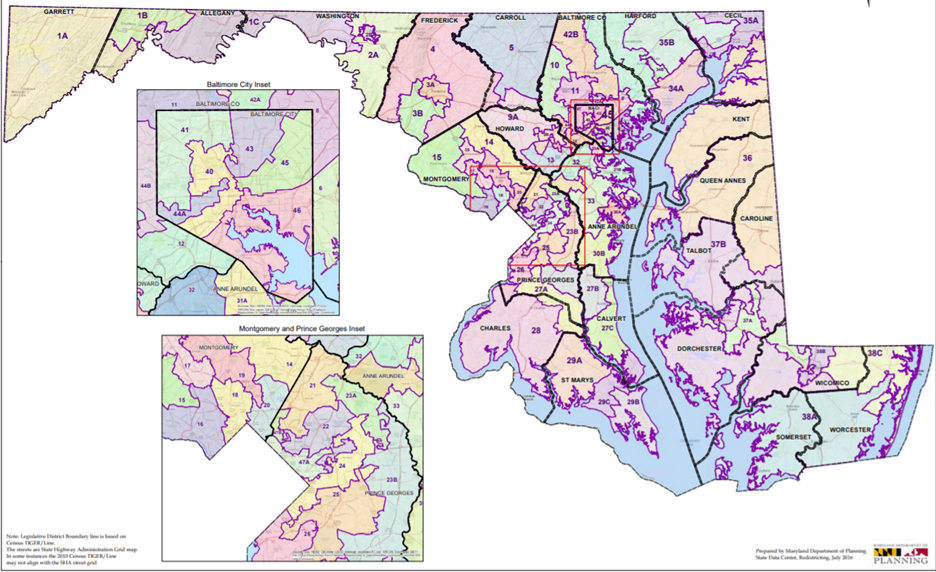ANNAPOLIS, Md. – One of Maryland’s two redistricting commissions is tasked with proposing a state legislative map using only single-member delegate districts, but the current mixed system still has significant support.
Unlike most other states, which elect one representative per district in the state’s lower chamber, Maryland uses a system that includes districts with one to three delegates.
Gov. Larry Hogan, R, established the Maryland Citizens Redistricting Commission in an executive order in January and directed the commission to draw a legislative map using single-member delegate districts.
That would be a change from the current system, which uses a combination of single and multi-member districts.
Each state Senate district has three representatives. In some districts, all three represent the entire territory, while in others the district is divided into three smaller areas.
In still other places, one delegate district has been carved out, while the remaining population is represented by two people.
The mixed system has its supporters, who say the system leads to greater diversity of representation.
Jackie Coolidge is part of the redistricting team for the League of Women Voters of Maryland, a nonpartisan public policy group.
She told Capital News Service the league supports the current system because it has helped make the Maryland General Assembly “one of the most racially and ethnically diverse in the country.”
Coolidge says the system also leads to greater gender diversity.
“It looks as though it’s a bit easier for women to win a seat in a multi-member election,” Coolidge said. “And of course we like that.”
Multi-member districts have historically been used to disenfranchise Black voters, and Coolidge said some of Maryland’s single-member districts were drawn to create seats more likely to be won by people of color.
However, drawing those single member districts depends on a history of housing segregation and racist zoning and won’t work for all minority groups in all places, according to Del. David Moon, D-Montgomery.
“If it were Asians, for example, I don’t know how many districts there are in Maryland where you’d have a concentration large enough that you could guarantee electoral outcomes for a single-member district,” Moon said.
He supports keeping single-member districts as a tool, but believes his own district’s diverse slate of officials — including several people of color — is a product of the multi-member system.
“The whole history of having to just choose one is not a history that has been leading to the most diverse representation,” Moon said.
As a delegate, Moon has also seen how representatives from multi-member districts can work together.
During the height of the pandemic, Moon’s constituents had issues filing unemployment claims.
He said he and his fellow delegates for District 20 were able to divide and conquer the “huge” number because the district's constituents are shared among them.
On other issues, Moon said his constituents can benefit from their three delegates serving on different committees.
For instance, Moon said his colleague Del. Jheanelle K. Wilkins, D-Montgomery, takes the lead on renters’ issues, while Del. Lorig Charkoudian, D-Montgomery, handles utility assistance.
Del. Haven Shoemaker, R-Carroll, also collaborates with the delegates from his district, but he would prefer to move to a single-member system.
He said he’s seen constituents confused by the multi-member system, sometimes believing that the delegate living nearest to their area of the county is their only representative.
“It’s kind of counterintuitive to have, particularly this hodgepodge,” Shoemaker said.
Shoemaker thinks the mix of single and multi-member districts underrepresents people of color and Republicans.
He’s not alone in his suspicion that the current legislative map is a result of partisan strategy.
In 2015, the Maryland Redistricting Reform Commission released a report recommending the governor and Legislature consider a single-member system.
The report said the commission heard testimony in favor of that system, some of it from Republican members of the Legislature. They also heard support for three-member districts.
“Little if any testimony supported the current practice in which different methods are arbitrarily imposed on different areas around the state,” the report reads. “With the inconsistency of practice creating a strong suspicion that the discretion is being abused for tactical political ends.”
The report specifically called for an end to the practice of creating one single-member and one double-member delegate district within the same Senate district, unless it was required by federal law.
The Maryland Constitution allows for a mix of single and multi-member districts.
Maryland is one of only 10 states that continue to use multi-member districts, according to Ballotpedia.
The Maryland Citizens Redistricting Commission will submit legislative and congressional map proposals to the governor, who will send final plans to the Legislature.
Meanwhile, the Legislature has its own group working on maps: the Legislative Redistricting Advisory Commission.
The Legislature, where Democrats hold a supermajority, has final say on which maps become law.
Moon and Shoemaker both expect the eventual map will use a mix of single and multi-member districts similar to the current one.
The Maryland Citizens Redistricting Commission plans to hold a virtual working session Thursday evening at 6 p.m.
The Legislative Redistricting Advisory Commission also plans to meet Thursday at 6 in the Student Dining Hall at Anne Arundel Community College.
[Like what you're reading? Subscribe to our newsletter for more!]

